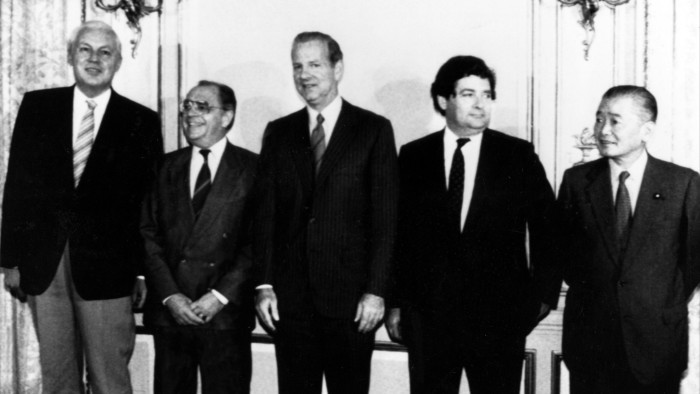Unlock the White House Watch newsletter for free
Your guide to what Trump’s second term means for Washington, business and the world
The writer is former vice-chair of the Federal Reserve and global economic adviser at Pimco
The September 1985 Plaza Accord and the subsequent February 1987 Louvre Accord are justly lauded today as significant successful examples of international economic policy co-operation.
These agreements aimed to engineer an orderly depreciation of a very overvalued dollar and to reduce what had become a massive US trade deficit as well as to turn back the rising protectionist pressures triggered by it. In the event, by 1987 the orderly dollar depreciation had been delivered and by 1989, the trade deficit as a share of GDP had been cut by two-thirds. Plaza-Louvre: Mission Accomplished.
Direct foreign exchange currency market intervention has been widely believed to have played a significant, perhaps decisive role, in delivering the weaker dollar and smaller trade deficits. This, however, is a myth that has persisted.
It is an appealing one. Wouldn’t it be remarkable if a country could virtually eliminate its trade deficit simply by coordinating foreign exchange market intervention with like-minded allies? But it is also wrong. In fact, the historical record provides a much different set of lessons that should be relevant to any current discussion or plans for a so-called Mar-a-Lago currency agreement aimed at reducing the US trade deficit.
In September 1985, representatives from the G-5 nations of the US, Germany, Japan, the UK, and France convened to address the appreciation of the dollar. The resulting Plaza Accord committed the participating countries to co-ordinated foreign exchange interventions. The primary motivation was to alleviate protectionist pressures and reduce the US trade deficit, which had reached about 3 per cent of GDP.
Two years later, the Louvre Accord was signed in Paris. This agreement marked a shift in policy, as the participating nations concluded that the dollar had depreciated sufficiently and agreed to stabilise exchange rates around existing levels to prevent further volatility.
However, empirical evidence and academic research suggests that co-ordinated intervention, although symbolically significant, was not the primary driver of the dollar’s depreciation between 1985 and 1987.
Instead, it was the substantial easing of US monetary policy under Federal Reserve Chair Paul Volcker that played the decisive role. Volcker by late 1984 had successfully broken the back of the double-digit inflation he inherited in 1979, had plenty of room to cut interest rates. Indeed, between October of 1984 (11 months prior to the Plaza Accord) and December 1986 (2 months before the Louvre Accord), the Fed cut interest rates from 12 per cent to 6 per cent and a weaker dollar soon followed and in near lockstep with these rate cuts.
US fiscal consolidation was also crucial to reducing the trade deficit. Despite making initial tax cuts and defence spending increases in 1981, the Reagan administration in later years worked with the Congress to enact significant fiscal tightening measures. These measures taken together reduced US budget deficits by nearly 40 per cent and were essential in narrowing the US trade deficit in the context of an expanding economy. Crucially, the original Plaza Accord communiques explicitly highlighted that fiscal adjustment in the US, Japan and Germany would be required to reduce global trade imbalances, and, at least in the US, they were delivered.
Recent discussions have emerged regarding a potential “Mar-a-Lago Accord”, drawing analogies to the Plaza and Louvre Accords. Advocates such as economist Zoltan Pozsar and chair of the US Council of Economic Advisers Stephen Miran have in the past discussed co-ordinated interventions to weaken the dollar, coupled with novel fiscal arrangements, including swapping short-dated US Treasury holdings for long-dated or perpetual bonds held by foreign central banks. Additionally, some proponents suggest linking currency co-operation with security arrangements and tariff reductions.
The Plaza and Louvre Accords provide valuable historical lessons. While co-ordinated currency intervention can signal policy intent and temporarily influence exchange rates, sustainable adjustments require supportive monetary and fiscal policies. The proposed Mar-a-Lago Accord, while conceptually similar, faces distinct contemporary challenges, including limited monetary policy flexibility, uncertain fiscal consolidation prospects, and complex geopolitical considerations.
Policymakers must recognise that successful international co-ordination requires credible commitments across monetary, fiscal, and geopolitical dimensions, rather than relying solely on currency intervention.
Source link









